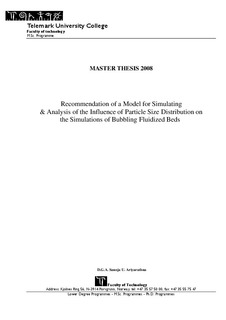| dc.description.abstract | A computational study of the influence of particle size distribution on bubbling fluidized beds is performed. Several simulations are performed using Eulerian multiphase model for a two dimensional fluidized bed with an air jet as preliminary work. The commercial software FLUENT is used to perform the simulations. A combination of the models available in FLUENT is finalized as a good combination to be used in the main work. The finalised combination of models is used to simulate a two dimensional fluidized bed with uniform distribution of air in order to check the influence of particle size distribution on simulations. The “Syamlal O’Brien Symmetric” drag model is used to introduce the solid-solid drag forces and the “Syamlal O’Brien” drag model to introduce the solid-fluid drag forces. Five simulations are performed with increasing number of particle phases in the bed, such as, one simulation with one particle phase, two simulations with two particle phases and two simulations with three and four particles phases in each. The five simulations are compared with each other and with an experiment performed by Mr. Wu W.J. Representation of the particle size distribution in the simulations is arranged according to the particle distributions of the particle mixture used in the reference experiment except in one simulation. Each particle phase is represented by the corresponding mean particle diameter. The same mean particle diameter persists in all five simulations. The comparison conducted in terms of the particle segregation, expansion of the particle bed and the bubble behaviour in the particle bed. All simulated mixtures have predicted particle segregation, bubbles in the bed and expansion in the particle bed, except the simulation with only one particle phase. The reason is found as the superficial gas velocity used in the simulations, which is well bellow the minimum fluidization velocity of the particles used in the bed. Prediction of particle segregation in simulations is analyzed using contours of the particle phases as well as the plots of volume fraction (VOF) data it self. The progress of the particle segregation also analyzed using VOF data of particle phases at along the height of the bed and at selected points of the bed. Bubble behaviour prediction is analyzed in terms of bubble velocity, bubble frequency, bubble distribution in the bed and the lowest position of bubble occurrence in the bed. The bed expansion in the simulations is compared with the reference experiment using contours of the particle phases. Comparison of the simulated results with the reference experiment showed that the higher the number of particle phases the better the prediction of particle segregation, bubble behaviour and the bed expansion in the simulations. Also it is observed that, the closer the presentation of the particle size distribution in the simulation to the mixture used in the experiment the better the prediction of the dynamics of the particle bed. Two abstracts have been sent to the AICHE – 2008 annual meeting and SIMS 2008 conference using some of the work performed related to this study. | |
